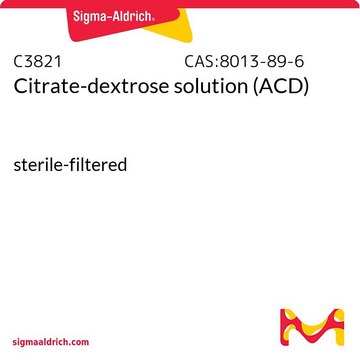C3434
Citrato de sodio tribásico dihydrate
BioXtra, ≥99.0% (titration)
Sinónimos:
Citrato de trisodio dihydrate, Ácido cítrico trisodium salt dihydrate
About This Item
Productos recomendados
product line
BioXtra
Quality Level
assay
≥99.0% (titration)
form
powder or crystals
impurities
Insoluble matter, passes filter test
pH
7.5-9.0 (20 °C, 0.1 M in H2O)
mp
>300 °C (lit.)
solubility
H2O: 0.1 M at 20 °C, clear, colorless
anion traces
chloride (Cl-): ≤0.001%
sulfate (SO42-): ≤0.005%
cation traces
Al: ≤0.0005%
As: ≤0.00001%
Ba: ≤0.0005%
Bi: ≤0.0005%
Ca: ≤0.005%
Cd: ≤0.0005%
Co: ≤0.0005%
Cr: ≤0.0005%
Cu: ≤0.0005%
Fe: ≤0.0005%
K: ≤0.01%
Li: ≤0.0005%
Mg: ≤0.0005%
Mn: ≤0.0005%
Mo: ≤0.0005%
NH4+: ≤0.001%
Ni: ≤0.0005%
Pb: ≤0.0005%
Zn: ≤0.0005%
absorption
≤0.010 at 260 in H2O at 0.1 M
≤0.010 at 280
SMILES string
O.O.[Na+].[Na+].[Na+].OC(CC([O-])=O)(CC([O-])=O)C([O-])=O
InChI
1S/C6H8O7.3Na.2H2O/c7-3(8)1-6(13,5(11)12)2-4(9)10;;;;;/h13H,1-2H2,(H,7,8)(H,9,10)(H,11,12);;;;2*1H2/q;3*+1;;/p-3
InChI key
NLJMYIDDQXHKNR-UHFFFAOYSA-K
¿Está buscando productos similares? Visita Guía de comparación de productos
Biochem/physiol Actions
Storage Class
11 - Combustible Solids
wgk_germany
WGK 1
flash_point_f
Not applicable
flash_point_c
Not applicable
ppe
Eyeshields, Gloves, type N95 (US)
Elija entre una de las versiones más recientes:
¿Ya tiene este producto?
Encuentre la documentación para los productos que ha comprado recientemente en la Biblioteca de documentos.
Los clientes también vieron
Artículos
Sigma-Aldrich presents an article about how proliferatively active cells require both a source of carbon and of nitrogen for the synthesis of macromolecules. Although a large proportion of tumor cells utilize aerobic glycolysis and shunt metabolites away from mitochondrial oxidative phosphorylation, many tumor cells exhibit increased mitochondrial activity.
Information on fatty acid synthesis and metabolism in cancer cells. Learn how proliferatively active cells require fatty acids for functions such as membrane generation, protein modification, and bioenergetic requirements. These fatty acids are derived either from dietary sources or are synthesized by the cell.
Nuestro equipo de científicos tiene experiencia en todas las áreas de investigación: Ciencias de la vida, Ciencia de los materiales, Síntesis química, Cromatografía, Analítica y muchas otras.
Póngase en contacto con el Servicio técnico
